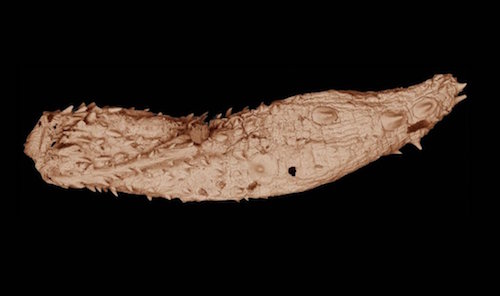 Evolution
Evolution
Fossil Discovery Adds Another Phylum to the Cambrian Explosion

The Cambrian explosion just got a bit more explosive with the discovery of a likely member of phylum Kinorhyncha from rocks in South China that are about 530 million years old. If you’ve never heard of kinorhynch worms, also called “mud dragons,” that’s probably because they are very tiny, seldom discussed, and found living only in certain marine environments around the world. As the Encyclopedia of Life explains:
Around 150 species of kinorhynchs have been described since this group was first discovered on the northern coast of France in 1841, nearly all of them less than 1 mm long. They have been collected as far north as Greenland and as far south as Antarctica, as well as in the Black Sea. Most live in marine sand or mud from the intertidal zone to a depth of 5000 to 8,000 meters, but some are known from algal mats or holdfasts, sandy beaches, and brackish estuaries and others have been found living on hydrozoans, bryozoans, or sponges.
Science Daily reports on the fossil, noting that “[a]n historic find — made in South China — fills a huge gap in the known fossil record of kinorhynchs,” since the new fossil species, Eokinorhynchus rarus, is very similar to living kinorhynchs:
Similarities between the fossils of E. rarus and living, modern kinorhynchs include their hollow spines arranged in a five-fold symmetry and their body segments each consisting of articulated plates. However, E. rarus differs from modern species with more numerous segments. Hence the belief of an ancestorship.
The technical paper, “Armored kinorhynch-like scalidophoran animals from the early Cambrian,” puts it this way:
Here we describe several early Cambrian (~535 million years old) kinorhynch-like fossils, including the new species Eokinorhynchus rarus and two unnamed but related forms. E. rarus has characteristic scalidophoran features, including an introvert with pentaradially arranged hollow scalids. Its trunk bears at least 20 annuli each consisting of numerous small rectangular plates, and is armored with five pairs of large and bilaterally placed sclerites. Its trunk annuli are reminiscent of the epidermis segments of kinorhynchs…. Eokinorhynchus rarus also shows intriguing similarities with extant kinorhynchs, suggesting a close phylogenetic relationship.
In Figure 2.5 of Darwin’s Doubt, Steve Meyer reports that about 20 of 27 animal phyla with known fossil records appear in the Cambrian period. Prior to this find, phylum Kinorhyncha was not known to have a fossil record. Now we can update Meyer’s tabulation to report that 21 of the 28 phyla with known fossil records apparently first appear — abruptly no less — in the Cambrian explosion of animal body plans.
Despite this non-Darwinian pattern of origin, the papers’ authors speculate that these ancient (and extant) kinorhynchs might shed light on the origin of arthropods, but that’s largely only because they are segmented — as various other living phyla are as well. Given that kinorhynchs entirely lack limbs and also lack arthropod-like eyes, it seems that they aren’t going to help us much towards understanding the unique defining characteristics of arthropods.
The paper also explains that these fossils come from about 535 million years ago in a section of strata bearing the “small shelly fossils,” in the early Cambrian period. As Meyer and I have discussed, some mistakenly cite the “small shelly fossils” (SSFs) as possible evidence of a gradual evolution of the Cambrian animals. But in this case, studies of the SSFs are showing the Cambrian explosion to be more explosive.
The paper even suggests that studying these enigmatic SSFs may reveal that known phyla are represented in species not previously assigned to living groups:
Nonetheless, the paleontological data and phylogenetic interpretation presented here invite further exploration of the phosphatization taphonomic window and careful re-examination of small shelly fossils (e.g., Paracarinachites spinus and Kaiyangites novoli) in search of Cambrian kinorhynchs.
If they’re right, then correctly classifying SSFs might be key to understanding the abrupt appearance, not gradual evolution, of the Cambrian phyla. This reminds me of a comment by Douglas Erwin and James Valentine in The Cambrian Explosion where they predicted that even some small and soft-bodied phyla without fossil records likely first appeared in the early Cambrian:
[A] great variety and abundance of animal fossils appear in deposits dating from a geologically brief interval between about 530 to 520 Ma, early in the Cambrian period. During this time, nearly all the major living animal groups (phyla) that have skeletons first appeared as fossils (at least one appeared earlier). Surprisingly, a number of those localities have yielded fossils that preserve details of complex organs at the tissue level, such as eyes, guts, and appendages. In addition, several groups that were entirely soft-bodied and thus could be preserved only under unusual circumstances also first appear in those faunas. Because many of those fossils represent complex groups such as vertebrates (the subgroup of the phylum Chordata to which humans belong) and arthropods, it seems likely that all or nearly all the major phylum-level groups of living animals, including many small soft-bodied groups that we do not actually find as fossils, had appeared by the end of the early Cambrian. This geologically abrupt and spectacular record of early animal life is called the Cambrian explosion. (The Cambrian Explosion, p. 5, emphases added)
It would seem that this new small, soft-bodied fossil find confirms that Erwin and Valentine are probably correct.
Image: Eokinorhynchus rarus fossil, via Virginia Tech.
